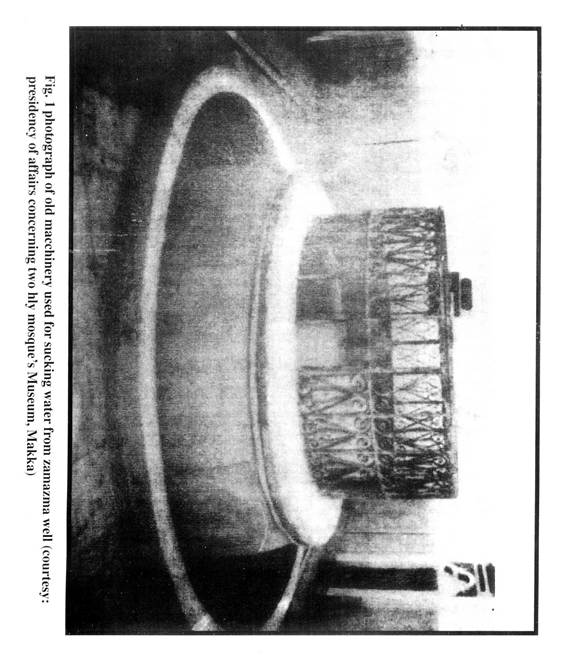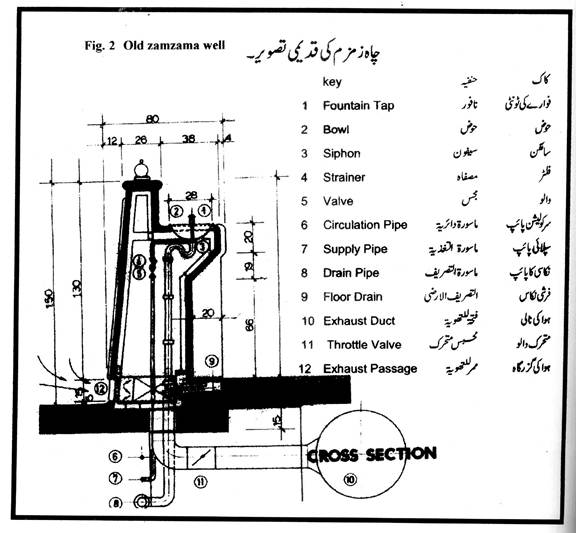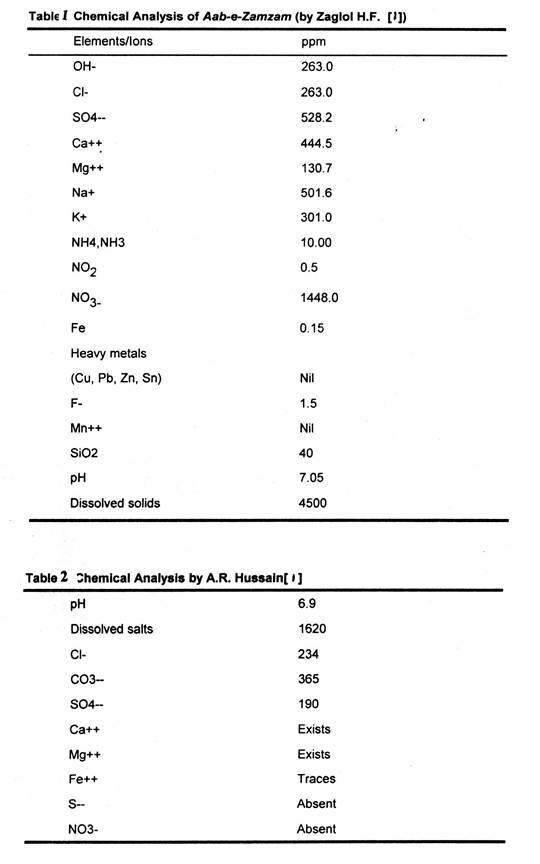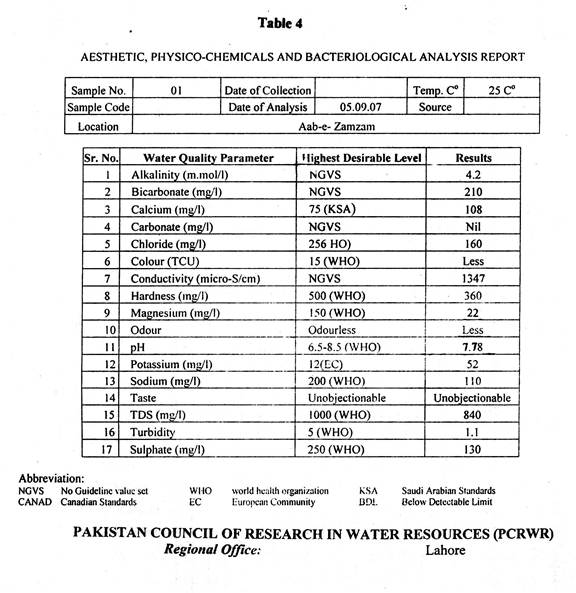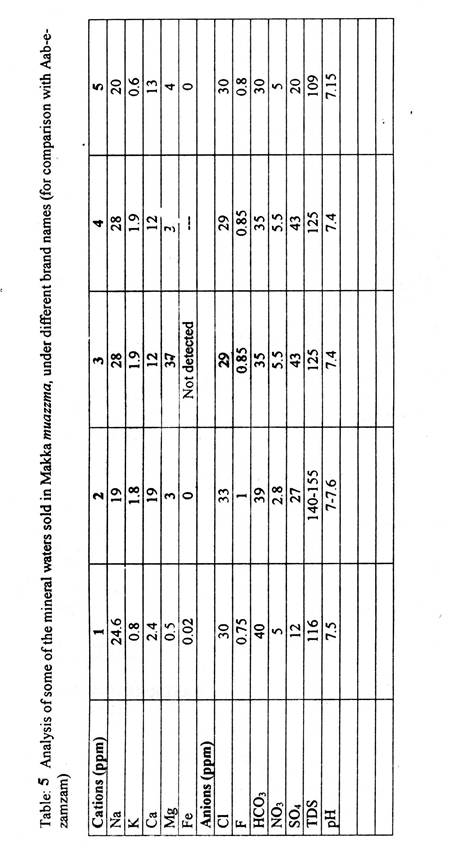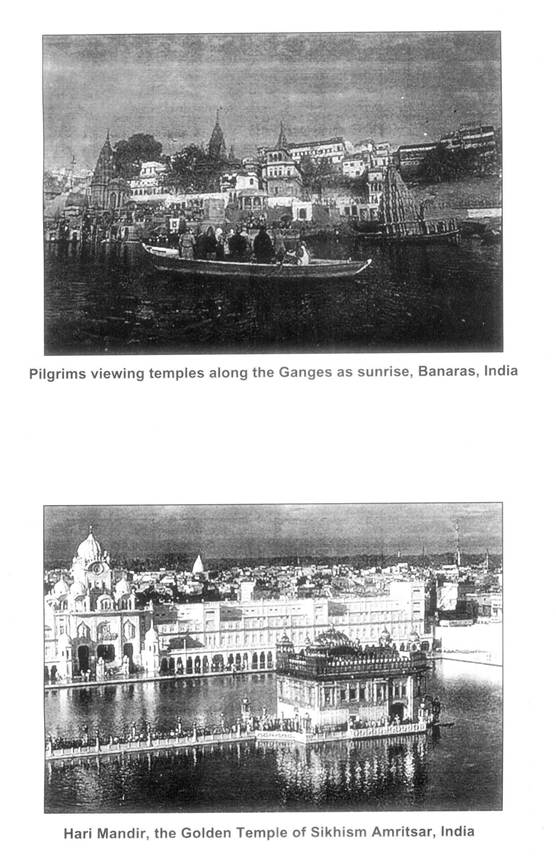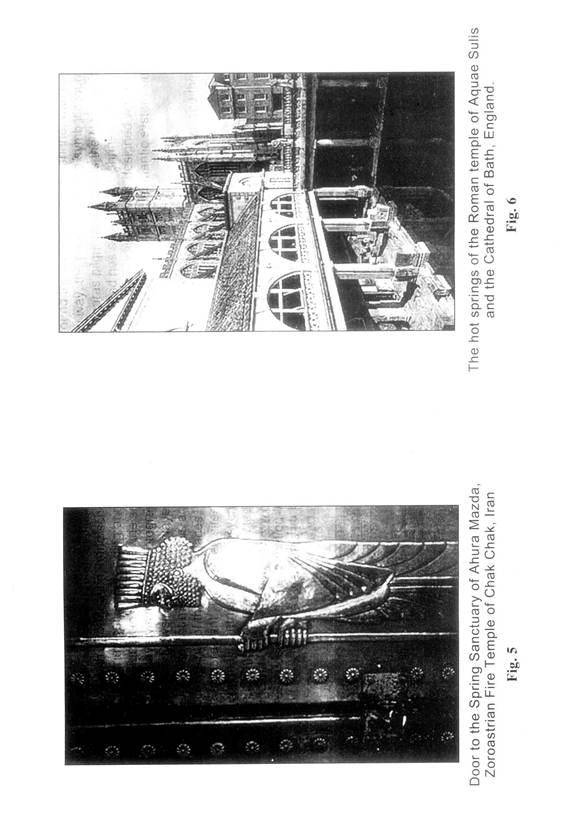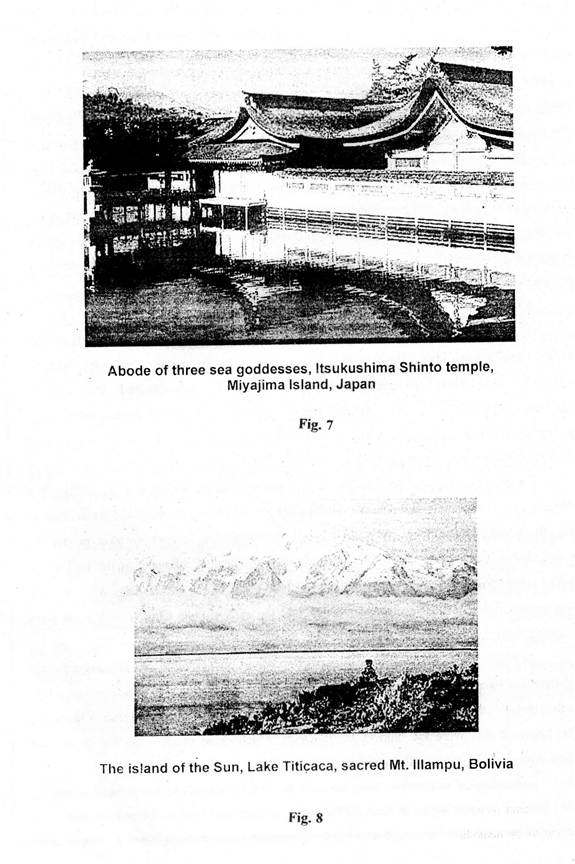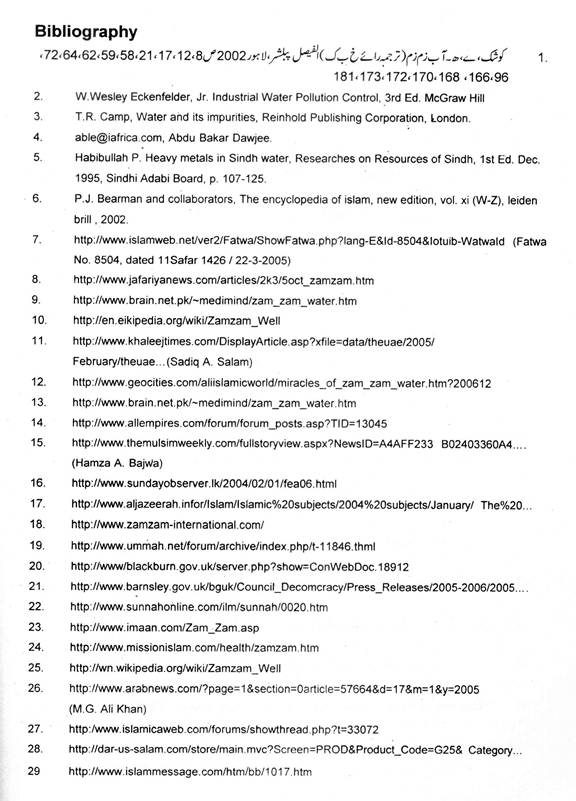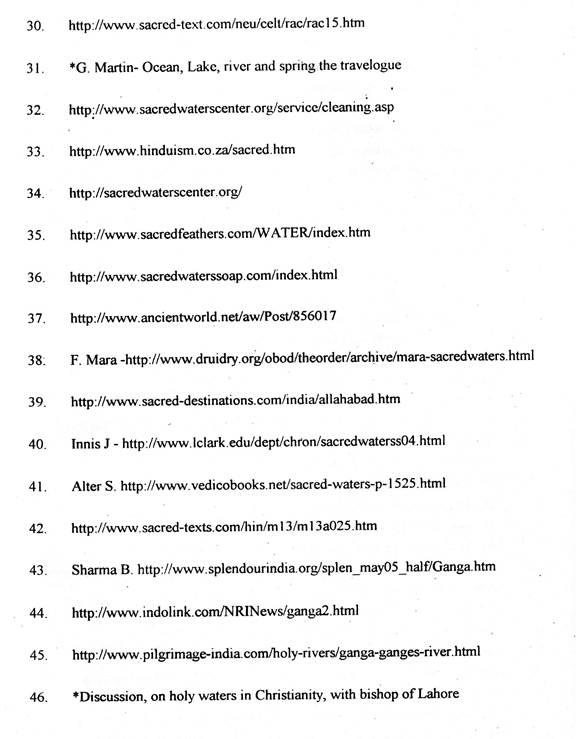|
||||||||
|
|
Aab-e-Zamzam The sacred well, Zamzam, is
situated at the perimeter of the sacred complex of
Significance of
Name (in light of rawayat) The noun zamzam is of
onomatopoeic type of word (formation of word from sound associated with thing
named). It is apparently to be associated with the qualificatives zamzam or
zunazim which denote, according to mediaeval Arabic dictionaries, an
"abundant supply of water", ma zumazmi - kathir or in ancient contests a
"water-point" regarded as "never drying up". Explanations are given in other
mythic accounts mostly constructed according to the sense-also onomatopoeic
type-which associates the qualificatives zamzam and zumzim with a
dull sound. This sound can apply equally well to a distant roll of thunder
presaging rain, or to any guttural sound with closed mouth emitted by an animal
(camel or horse, etc.) or by a man. The mediaeval Arabi sources
generally attribute the murmuring of the zamzama to the sayings or to the
prayers of the Zoroastrians. Their association with the well of Zamzam is
described in the following fashion: They made regular pilgrimages to In another version relayed by
Yakut, it is the angle Gabriel (AS) himself who is said to have murmured over
the well. Hagar (Hajra Bibi, RAT) and her son Hz Ismail (AS) brought by Abraham
to According to al-'Ayni,
the noun zamzam is to be understood as deriving from zamazima, the
precious "bridles" that the eponymous ancestor of the Sasanids is supposed to
have donated to the well. [6]
Creation There is very early reference to
the story of Hagar (Hajra Bibi, R.A.T.) and the discovery of the source of
water/Hajra Bibi R.A.T. was searching for the water for her thirsty son (Hz
Ismail AS) The tiny child was crying due to thirst and rubbed his little heels
on the sand suddenly water gushed up from the sand where Hz Ismail (AS) rubbed
his heels. The rediscovery of the source, accompanied by miraculous signs,
attributed to Hz Abd al-Muttalib, the grandfather of Holy Prophet (Peace be upon
him!). In the latter case, it is a typical revival story. This is taken to
justify the function of giving water to pilgrims, sikaya, which was to
remain in the lineage of al-Abbas, one of the sons of Hz Abd al-Muttalib, under
of Holy Prophet (Peace be upon him!), and ancestors of the Abbasid dynasty. Before its revival by the family
of Holy Prophet (Peace be upon him!) the water source which had sprung up "in
the time of Hagar (Hajra Bib R.A.T)" was dried up by God on account of the
misconduct of the Diurhum. This tribe, supposedly of Yemeni origin, is
associated with Ismail (AS). The grandfather of Holy Prophet
(Peace be upon him!) is supposed to have found in the well that he had just
rediscovered offerings consisting primarily of gazelles cast in gold and
precious swords. Al-Masudi sees this as proof of the coming of "Persians" to
Origin In the absence of archaeological
proofs, different hypotheses of historical topography of the well have been
proposed. It could be thought that the presence of this probably perennial water
(Wellhausen describes it as a Quelle, a spring which is said to have been
the only Meccan water, (Reste, 76, n. 2); 'Ga«defroy-Demomobynes relays
the information given by mediaeval Arab geographers. According to which the well
was allegedly supplied by three springs, "towards the Black Stone" ... "a place
which is the confluence of numerous dry valleys in the lowest part (vulnerable
to occasional flooding by pluvial streams)". It is on the basis of this
singularity of terrain that the installation came about of the betylie complex
which probably constituted the original perimeter of the Ka 'ba mualla
and its adjacent sacred stones (al-Safa and al-Marwa). This sacred
complex would have taken precedence over the water-point, relegating it to
second place in ritual and in representation.
Importance The fervent faith of pilgrims,
from early Islamic times to this day, has not ceased to lend outstanding
qualities to the water of the well of Zamzam, which is perceived as
bearer of baraka and as a "curative source". It is stressed that Holy
Prophet (Peace be upon him!) drank this water and used it regularly for various
purposes. Zamzam, Yakut attributes to Mudjahid, taken to be a
habitual transmitter of Ibn Abbas, the following words: "It you drink at
Zamzam in the hope of a cure, God will cure you; if you are thirsty, God
will quench your thirst; if you are hungry, God will satisfy you!" This fervious has led to modes
of conduct which can be described as being of a magical type, for example: •
Linen dipped in the holy
water serving as a shroud •
After wadu (ablutions), and parts of the body dipped or sprinkled
by the water of Zamzam are also considered clean and pious. •
Zamzamiyyal, small phials of clay or metal sealed and sold as
containing water from the sacred well, are still today highly-prized by pilgrims
and are taken back by them to their own countries as gift for presenting to
their relatives and friends.
Other names of Zamzam Just as 'Zam-Zam' has many
virtues and benefits, similarly , it has many names, The following names are
recorded in "Lisaanul Arab": "Zam-zam, Maktoomah, Maghnoonah, Shubaaghanah,
Suqyaa, Ar-ruwaa, Rakdhatu Jibreel, Hazmatu Jibraeel, Shifaa-u-Suqm,
Ta'aam-u-Tu'am, Hafeer-atu Abdil Mutallib, Zam-zaam, Zawaa-zim" (LisanulArab,
vol. 15, page 166). It is reported from Hz Abdullah Ibn Abbaas (radhiallaahu
anhu) that during the era of ignorance it was known as 'Shubaa'a'. (Akhbaar
makkah, page 291). Imaam Zubaidi (rahmatuilahi alaih) states that if the various
names of 'Zam-zam' are gathered from the aahhdith kitaabs and
dictionaries, it will total up to 60 names. (Taajul Uroos, Vol. 8, Vol. 328)
[19].
Early chronological history When Zamzam well came
into being, it attracted the tribe of Banu Jurhum and led to their settling
down, in this area. They stayed and governed the area for 300 years, and
according to some narrations, 500 years. It was the immorality, mischief, and
flagrant disobedience of this tribe that led to their disgraceful eviction from
the pure But, when Allah ta'ala desired
to revive this well and satiate the ummat with it, He used the Quraish and the
grandfather of Holy Prophet Peace Be Upon Him, by way of a dream to dig up the
well. Abdul Mutallib used to say that one night he had a dream, wherein someone
was telling him to dig up. Tayyibah. He says that he asked: "What is
'Tayyibah'?" But the person (in his dream), just walked away, without giving a
reply. On the following night he said that he had another dream, wherein he was
told to dig up 'Maghnoonah". He says that he asked: "What is 'Maghnoonah'?" But,
again this person simply disappeared. On the third night he again had a dream
wherein he was told to dig up Zamzam, and clean it up. He says that, he
asked: "What is 'Zamzam'?". He was then told that it is a
well, whose water will never decrease, and that he will find no difficulty in
digging it up. Also that he will find no embarrassment in it, and that it is the
inheritance of his father. He was told to serve it to the Haajis. Abdul
Muttalib, says further that he asked for a sign of the location to this well. He
was told that it is at the place where the ant-hills are in abundance. He was
also told that when he would reach the place in the morning, he would find a
crow pecking at the exact spot, where he had to dig. The next morning, Hz Abdul
Mutallib left home towards the haram Shareef, with his eldest son, Hz Haarith,
taking with them a pic-axe and a spade According to the glad-tidings of Allah
ta'ala, he saw a crow pecking at a spot between the idols, 'Assaaf and Naila.
There were also many ant-hills around that spot. Following the instructions of
Allah ta'ala, both the father and son started digging. Even the Quraish, become a
hindrance, and objected by saying that this is the sacred place of their idols,
and that they will never consent to its being dug up. However, Hz Abdul Mutallib
did not listen to any of this and he continued his task. In a short space of
time he reached his objective and struck water. He also found the buried
treasures of the Jurhum, which they left there, upon their departure from Makkah
mukarrama. When the Quraish saw that Hz
Abdul Mutallib succeeded in his objective and that he unearthed a great
treasure, they laid claim to it as being the inheritance of their fore-father,
Hz Ismaeel (A.S). They therefore claimed a stake in it. They also wanted a share
in the distribution and protection of the Zam-Zam well, but Hz Abdul-Mutallib
rejected their claim and became the sole-custodian of the well. This led to a
conflict and they decided to call in a third party, to arbitrate the issue. They
decided on the tribe of Banu Sa'ad Bin Huzail, which was stationed in During the era of ignorance, two
idols, 'Assaaf and 'Naila' were kept upon the well of Zam-Zam. 'Assaaf was a
male and 'Naila', a female, who had a connection with the tribe of Jurhum, and
they were inhabitants of Imamul Mu'arrakheen, Allama
Azraqi, states; ' When Assaaf Bin Bughaa
and Naila Binti Zi'ib committed their vile and immoral act in the haram
shareef, then Rabb zul jalal turned them into stone. The people flung one of
them onto When the era of Qussay Bin
Kilaab came, he placed the statue of Assaaf near the Kaaba and that of Naila
near the well of Zam-Zam. Hence, the mushrikeen, used to begin their
tawaaf of the Kaaba mua 'ala at the statue of Assaaf and end at Naila.
They also made istilaam at these idols. Then, when Allaah ta'ala placed
the control of Makkah mukarrama in the hands of Rahmatul lil alameen, these two
idols (like all the others) were destroyed" The minds of the mushrikeen
were obscured due to their idol-worship. Soundness of mind leaves them. Just
look at this, where a totally immoral and depraved man and woman shamelessly
commit an act of indecency in front of the Kaaba shareef, and Allaah ta'ala
turns them into stone as a lesson for man to come, the mushrikeen turn
this very curse into their object of worship, from whom they ask of their needs.
Way of drinking zamzam water (for Muslims) It is better for the person who
drinks zamzama water, to combine two things: drinking by three sips and
breathing outside the container. Ibn Abbas said: "If you drink Zamzam water
drink your fill, turn towards the qiblah, say "bismillah" (in the name of
Allah) and breath three times and when you finish, you should say 'alhamdu
lillah' (all perfect praise be to Allah). [Al-haakim]. The sunnah when drinking
Zamzam or any other drink is to drink by three sips. Imam Al-bukhaari and muslim
reported that the Holy Prophet Peace Be Upon Him used to drink in three sips,
breathing outside the container. Ibn qataadah also narrated that Holy Prophet
Peace Be Upon Him forbade breathing into the container when drinking. When a
person drinks in one go, he will possibly breath into the inside of the
container (the thing which is forbidden) [7] |5].
Present dimensions of well Zamzama well 30 meter deep.
Depth to water is 3.23 meters. There are some springs contributing to the well
at approximately 13 meters to 12.72 meters below surface and then to 13.39
meters, after which the water level stopped to recede. Water level recovered to
3.9 meters below surface just 11 minutes after pumping had stopped. The aquifer
feeding the well seems to recharge from rock fractures in neighbouring mountains
around Distribution The sacred water is distributed
through taps (on earlier architectural features since the beginning of the
'Abbasid era), the basin for ablutions and the circular basin around the
curbstone of the well where water for drinking is collected in buckets and
lifted with the aid of a system of pulleys, to be subsequently transferred to
pitchers or earthenware casks. Purity of Zamzam water and
fake zamzam water scam [10,15,20,26] Many Muslims believe that the
water of the Zamzam well is divinely blessed (it is believed to satisfy both
hunger and thirst, and cure illness) and make every effort to drink of this
water during their pilgrimage. The water is served to the public through coolers
stationed throughout the masjid al haram in As the Muslim population of the
world has grown, and air travel has made the hajj more accessible to them, the
hajj is increasingly crowded. There can be up to four million pilgrims
performing the hajj. There is increasing concern that the Zamzam well may not be
able to provide enough water to satisfy all demands. There have been some attempts to
scientifically validate Muslim beliefs regarding the special nature of Zamzam
water. The water is said to contain high levels of some minerals: calcium,
magnesium, and fluoride. On the other hand, senior
experts of Bangladesh Atomic Energy Commission have found the water of Zamzam
well to be scientifically superior to tap or solar pump water. They have
analysed and tested samples of water from the Zamzam well and from tap and solar
pumps recently, 'it was found that the Zamzam water has a curative effect.
Alkaline in nature, the Zamzam water can neutralize excess hydrochloric acid
formed in the stomach and reduces heartburn. Iodide, sulphate and nitrate
contents are also much higher in the Zamzam water. Supply of Iodide "through
Zamzam may sufficiently fulfill the requirement of Iodide for the thyroid organ
of a body." The research carried out jointly by M.A. Khan, A.K.M. Sheriff, K.M.
Jdris Ali and M. Alamgir revealed that contents of micro-nutrients like
magnesium, sodium and potassium were manifold higher in Zamzam water than
in tap and solar pump water [16]. The kingdom of Saudi Arabia has
set up the Zamzam studies and research center (ZSRC) under the Saudi Geological
Survey (SGS), is working to determine scientific solutions for effective
monitoring and management of the acquifer feeding the Zamzam well and to ensure
the purity and security of supply," according to an abstract of the research
project obtained by Arab news. ZSRC is also focusing on storage and distribution
system currently in use. With the increasing number of pilgrims and visitors,
demand for Zamzam water has been continuously increasing. ZSRC also seeks to
estimate sustainable well yield and recommend measures to ensure that
sustainable supply limits are not exceeded. The research aims to present
solutions to those complex problems through an integrated approach to water
catchments management and conservation. "Through these actions, the quality and
quantity of supply from the Zam Zam well can be sustained to meet the spiritual
needs of the world's one and quarter billion Muslims," said the abstract. In
order to manage demand, water from Zam Zam well is pumped, treated and stored in
underground storage tanks on a continuous basis at the moment. Before
distribution among consumers and transportation to Madinah, Zam Zam water is
also treated by a series of sand filters, micro filters and ultraviolet
disinfection. The Saudi Geological Survey research center is also engaged in
designing and upgrading the treatment system. Already, two phases of upgrading
have been completed and the third phase is in active consideration. Moreover,
the research center follows these activities and ensures strict quality
assurance measures. Pilgrims habitually carry Zam Zam water back to their homes
in plastic containers of 10 or 20 liters which they fill themselves from access
points, situated around the Holy Mosque or at a central filling station. More
commonly they buy the filled containers from roadside venders on the outskirts
of Makkah. This distribution system is without standard hygienic conditions and
offsets the efforts of treatment. Therefore, the research center is in the
process of evaluation of the present filling system and design of upgrading
which will minimize direct human involvement and discourage peddling by vendors. The Saudi government, which
controls the Hijaz and According to the Royal embassy
of Executive member for citizen an'
consumer rights, councilor Frank Connor ( Public health authorities in the
emirate have decided to destroy large quantities of a brand of bottled water
which was being sold in the local markets claiming to be from Zamzam
after it was found unfit for human consumption. The Zamzam water was being
bottled in a local factory. The bacteriological and chemical tests carried in
Sharjah indicated that the water doesn't conform to the country's hygiene
specifications and has a high degree of salinity [11]. Principal Environmental Health
office, Dr Yunes Teinaz, who has been battling the problem for a number of
years, said it was imperative that the Muslim community be made aware of the
dangers of drinking this water containing high levels of arsenic and nitrate.
This water, which is on sale, has high levels of arsenic which can damage the
health especially in children and the elderly. It is poisonous water. He warned.
He added "I recommend the Muslim community not to buy any Zamzam water, but to
only take it from pilgrims who have visited the Holy land of Mecca and brought
back their own personal supply. They (pilgrims) should make sure that the water
is put in a proper recognized container [15].
1.
Bukhari: narrated Ibn Abbas: Allah's Apostle came to the drinking place
and asked for water. AI-Abbas said, "0 Fadl! Go to your mother and bring water
from her for Allah's Apostle ." Allah's Apostle said, "Give me water to drink."
Al-Abbas said, "O Allah’s Apostle! The people put their hands in it." Allah's
Apostle again said, 'Give me water to drink. So, he drank from that water and
then went to the Zam-zam (well) and there the people were offering water to the
others and working at it (drawing water from the well). The Prophet Peace Be
Upon Him then said to them, "Carry on! You are doing a good deed." Then he said,
"Was I not afraid that other people would compete with you (in drawing water
from Zam-zam), I would certainly take the rope and put it over this (i.e. his
shoulder) (to draw water)." On saying that the Prophet Peace Be Upon Him pointed
to his shoulder.
2.
Bukhari: narrated Ibn 'Abbas: The Prophet Peace Be Upon Him said, "May
Allah be merciful to the mother of Ishmael! If she had left the water of Zam-Zam
(fountain) as it was, (without constructing a basin for keeping the water), (or
said, "If she had not taken handfuls of its water"), it would have been a
flowing stream. Jurhum (an Arab tribe) came and asked her, 'May we settle at
your dwelling7' She said, 'Yes, but you have no right to possess the
water. They agreed."
3.
Bukhari: narrated Abu Jamra Ad-Dabi: I used to sit with Ibn 'Abbas in
4.
Bukhari: narrated Ibn 'Abbas: The Prophet Peace Be Upon Him said, "May
Allah bestow His Mercy on the mother of Ishmael! Had she not hastend (to fill
her water-skin with water from the Zamzam well). Zamzam would have
been a stream flowing on the surface of the earth. "Ibn Abbas further added,
"(The Prophet Peace Be Upon Him) Abraham brought Ismael and his mother (to
5.
Imaam Ibn Qayyim al-Jawziyah (may Allah have mercy on him) said: "Zamzam
water is the best and noblest of all waters, the highest in status, the dearest
to people, the most precious and valuable to them. It was dug by Jibreel and is
the water with which Allah quenched the thirst of Ismael."
6.
It was reported in Saheeh Muslim that the Prophet Peace Be Upon
Him said to Abu Dharr, who had stayed near the Ka'bah and its coverings for
forty days and nights with no food or drink other than (Zamzam): How long have
you been here?" Abu Dharr said: I have been here for thirty days and nights."
The Prophet Peace Be Upon Him said, "Who has been feeding you?" He said, " I
have had nothing but Zamzam water, and I have gotten so fat that I have folds of
fat on my stomach. 1 do not feel any of the tiredness or weakness of hunger and
1 have not become thing, " The Prophet Peace Be Upon Him said: "Verily, it is
blessed, it is food that nourishes," (narrated by Imam Muslim)
8.
Ibn al-Qayyim (may Allaah have mercy on him) said: Myself and others tied
seeking healing with Zamzam water and saw wondrous things. I sought healing with
it from a number of illnesses, and I was healed by the permission of Allah. I
saw someone who nourished himself with it for a number of days, half a month or
more, and he did not feel hunger; he performed tawaaf along with the
other people just as they did. And he told me that he consumed nothing but
Zamzam water for forty days and he had the strength to have intercourse with his
wife, to fast and to perform tawaqf numerous times. [Zaad al-Ma'aad]
9.
Shaykh Ibn 'Uthaymeen (may Allah preserve him) said: So you should have
the intention of you want to gain by drinking this water. He should drink his
fill, i.e., fill his stomach with it, until it is filled to the ribs, because
this water is good. A hadeeth has been narrated concerning this: this
difference between the believers and the hypocrites is drinking one's fill of
Zamzam water, (narrated by Ibn Maajah in al-manaasik, al-Haakim)
10.
Al-Boosairi said: this is a saheeh isnnad; its men are trustworthy. This
is because Zamzam water is not sweet; it is somewhat salty, and the believer
only drinks this somewhat salty water out of faith, believing that there is
barakah (blessing) in it. So when he drinks it, upto his fill, this is a sign of
faith, (Sharh al-Mumti').
Box No. 2
It will be interesting to note
observation of Egyptian doctor concerning impurities in Aab-e-Zamzam and a reply
given by KSA and displayed in the e-mail:
abie@iafrica.com Director:
Abu-Bakar Dawjee, research and Information Network (Rain) P.O box 26119,
Isipingo beach, Durban, South Africa 4115) In 1971, an Egyptian doctor
wrote a letter to the European press saying that Aab-e-Zamzam was not fit for
drinking! Fortunately, the news came to Late King Faisal who ordered the
ministry of Agriculture and Water Resources to investigate and send samples of
Aab-e-Zamzam to European laboratories for testing. The results of tests of water
samples by the European laboratories and the one, which was analyzed at a
laboratory in KSA, were found almost identical. "The difference between
Aab-e-Zamzam and other water (city water) was in the quantity of calcium and
magnesium salts. The content of these was slightly higher in Aab-e-Zamzam. This
may be why this water refreshes tired hajis, but more significantly, the
water contains fluorides that have an effective germicidal action. Moreover, the
remarks of the European laboratories showed that the water was fit for drinking.
Hence the statement made by the Egyptian doctor proved false. When this was
reported to King Faisal he was extremely pleased and ordered for issuance of
contradiction of the report in the European press" The salient features of
Aab-e-Zamzam can be summed up as follows: 1.
This well has never dried
up. On the contrary it has always fulfilled the demand for water. 2.
It has
always maintained the same salt composition and taste ever since it came into
existence. 3.
Its potability has always been universally recognized as pilgrims from
all over the world visit Khaan-e-Ka'aba every year for hajj and umrah, but have
never complained about it. Instead, they have always enjoyed the water that
refreshes them. Water tastes different at different places. 4.
This water has never
been chemically treated or chlorinated as is the case with water pumped into the
cities. 5.
Biological growth and
vegetation usually takes place in most wells. This makes the water unpalatable
owing to the growth of algae causing taste and odor problems. But at the well of
Aab-e-Zamzam no such biological growth is observed. 6.
Centuries ago, Bibi Hajra searched desperately for water in the hills of
Sufwa and Murwa for her newly born son Hazrat Ismail. As she ran from one place
to another in search of water, her child rubbed his feet on the sand. A pool of
water sprung off, and by the grace of God, shaped itself into a well, which is
Aab-e-Zamzam.
Sacred waters known in religions other than Islam [30]
[31] [33] [35] [37-40] [43] [45]
Like aab-e-zamzam which is sacred for muslims. some other waters from oceans,
rivers and springs arc sacred for followers of other religions
The
In the Christian tradition, the pool of
Visitors to Hindu and Shinto temples will often sprinkle blessed water upon
themselves before entering the sacred places, Sikhs immerse themselves in the
holy waters of Hari Mandir.
Bormanus, Bormo or Borvo, Danuvius (the Danube), and Luxovius are found on
inscriptions as names of river or fountain gods, but goddesses are more
numerous—Acionna, Aventia, Bormana, Brixia, Carpundia, Clutoida, Divona, Sirona,
Ura—well-nymphs; and Icauna (the Yonne), Matrona, and Sequana (the
Seine)—river-goddesses [30].
The spirit of the waters was often embodied in an animal, usually a fish. Even
now in
In spite of twenty centuries of Christianity and the anathemas of saints and
councils, the old pagan practices at healing wells have survived a striking
instance of human conservatism. S. Patrick found the pagans of his day
worshipping a well called Slan, "health-giving," and offering sacrifices to it,
and the Irish peasant today has no doubt that there is something divine about
his holy well [30],
Certain waters had the power of ejecting the demon of madness. Besides drinking,
the patient was thrown into the waters, the shock being intended to drive the
demon away, as elsewhere demons are exorcised by flagellation or beating. The
divinity of the waters aided the process, and an offering was usually made to
him. In other cases the sacred waters were supposed to ward off disease from the
localities. Hinduism Ganga/Ganges river
The
The mahabharata described the virtues of
In September 1995, I visited
However, industry is not the
only source of pollution. The sheer volume of waste estimated at nearly 1
billion liters per day, of mostly untreated raw sewage - is a significant
factor. Also, inadequate cremation procedures contribute to a large number of
partially burned or unbumed corpses floating down the The made to grape this religion was
like liquid through my fingers - there was nothing sure and solid However, I did
discover one thing common among Hindus: an obsession with The sacred sangam The sacred sangam is the
confluence of three of the holiest rivers in Hindu mythology - Christianity It is an extraordinary thing to
consider that there are still literally thousands of holy wells in the British
Isles Most of these are natural springs; some open pools like St. madron's,
while others are contained by a stone edifice, often covered. The majority,
however, are in ruins, overgrown and no longer visited. Some have been
desecrated by cattle or human presence. And yet, many, like St. Madron's still
continue to be a center of pilgrimage as they were from pagan times [38] People visited the wells for
their traditional virtues of healing and divination. If a physical cure was
sought, the believer would drink or sometimes bathe in the water. And in fact,
the water of some holy wells have indeed been found to contain curative
properties, mostly -due to the presence of certain minerals. But the healing
influence of the well s was due to more than their medicinal qualities The holy
wells of the At
Archaeological excavations have
revealed the human use of the hot mineral springs at This great healing shrine of
Aquae Sulis was constructed following the departure of the Roman legions from
Britain early in the fifth century AD, then, city and its splendid temples and
baths swiftly fell into decline Over time the baths were covered by the
relentless silting of the spring and only the fallen temple of Sulis-mmerva
marked the ancient sacred site. Yet the town was not abandoned. Rather it
continued to grow and by the seventh century the first Christian structure had
been established directly upon the ruins of the Roman temple For the next twelve
hundred years a succession of churches rose and fell upon the hallowed ground. Buddhism Located near Situated high in the Bolivian
Andes (at 3856 meters and covering 8000 square kilometers), Lake Titicaca is the
pre-eminent holy place of all ancient Andean cultures and the source of a
hundred cosmogenic myths. Legends say that long ago in a forgotten time the
world experienced a terrible storm with tremendous floods. The lands were
plunged into a period of absolute darkness and frigid cold, and humankind was
nearly eradicated. Some time after the deluge, the creator god Viracocha arose
from the depths of
Summary The sacred
well, Zamzam, is situated at the perimeter of the sacred complex of
|
|||||||
